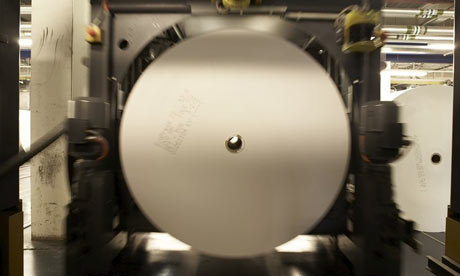Guardian takes another major step to meeting the 10:10 challenge
Hydro-electric power the key to reducing carbon footprint of the paper supply chain

A roll of newsprint at the Guardian Print Centre
The Guardian's commitment to the 10:10 campaign has received a welcome boost with news that it is expected to cut the carbon footprint of its paper supply by at least 10% this year.
This is particularly significant given that newsprint and magazine paper accounts for more than two-thirds of traditional media companies' overall direct and indirect CO2 emissions.
Guardian News & Media (GNM), which owns the Guardian and Observer, had already committed to seeking to reduce the CO2 emissions of its directly-controlled operations, including its offices and print sites, by a tenth this calendar year.
This is in line with the aims of the 10:10 campaign, which is seeking to unite every sector of British society behind one simple idea: to achieve a 10% cut in the UK's carbon emissions in 2010
GNM's parent company Guardian Media Group will be achieving the reduction in paper emissions by switching some of its newsprint supply to a low carbon Norwegian mill which emits a tiny 9.45 kilogrammes of CO2 per tonne of paper.
This compares with the previous supplier, a UK recycled mill, which produced more than 100 times that amount; 976 kilogrammes per tonne.
The fibre source for the Norwegian Mill is 56% recycled and 44% certified virgin.
The vast majority of the difference in the CO2 emissions is down to the fact that the Norwegian company uses hydro-electricricity, while UK paper manufacturers use the national grid, which is largely powered by fossil fuels.
In recent years, GMG, which buys paper for all the businesses in the group ranging from the Manchester Evening News to Autotrader, has been increasing the recycled content of its paper and setting targets to raise the proportion of virgin paper that is covered by certification programmes, which ensure the pulp comes from well managed forests.
More recently it has been concentrating its efforts on measuring the carbon intensity of its paper suppliers and recently changed its paper purchasing policy to ensure that CO2 emissions are taken into account in contract decisions.
The switch of suppliers was necessitated by a 30% drop in demand for newsprint in GMG in 2009, which meant it made sense to reduce the number of core suppliers from six to five; three UK recycled mills and and one each from Norway and Canada.
The fibre source for the Norwegian mill is 56% recycled and 44% certified virgin.
While the paper will be travelling further, research has shown that the carbon impacts of transporting paper is much smaller than the emissions from its production.
The hoped-for 10% plus drop in emissions from GMG's paper supply is on a like-for-like basis and does not take into account a drop in the volume of paper being used, which was caused by continuing declines in demand for printed products as well as reduced pagination and the grammage of paper used.
Steve Gould, GMG's paper purchaser, said: "We have increasingly been integrating environmental considerations into our paper purchasing plans, whereas in years gone by the key criteria had been purely around economic factors such as price, quality and security of supply.
"In this particular case, we needed to re-arrange our portfolio of suppliers and having good quality CO2 data meant that there was a clear advantage in letting go of one of our UK recycled suppliers and switching to Scandanavian paper.
"This means that we should be able to reduce the carbon footprint in line with our 10:10 commitment.
"We recognise the importance in maintaining a high level of recycled paper and in fact last year GMG's recycled content was 78%. But we also need virgin paper to be entering the supply chain as the paper fibres wear out after they have been recycled about six times."
For a broader look at our journey towards sustainable paper supply, please read our latest blog on the issue.
No comments:
Post a Comment